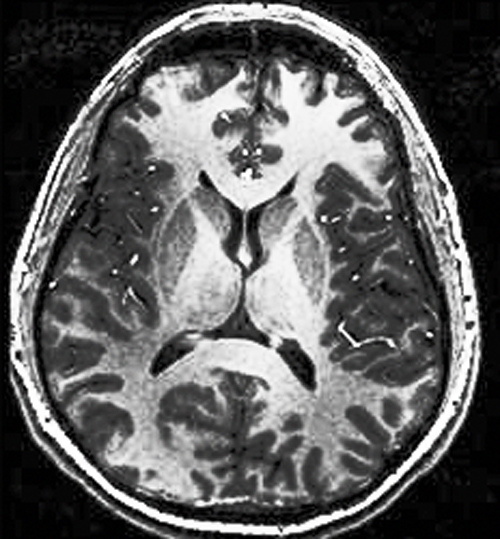|
Abnormal bright and dark areas due to B1 field inhomogeneity are frequently noted at very high fields (3T and above). Although the nature of these artifacts is not entirely clear, these are commonly referred to as dielectric artifacts.
|
|
The argument that these artifacts are due to dielectric effects is based on considering RF-wavelengths in tissues as a function of field strength. As can be seen in the diagram left, at fields of 1.5T and lower, RF wavelengths are long compared to the size of the body. As the magnetic field is increased, these wavelengths become the same or smaller than the anatomic regions imaged. In theory standing wave currents might arise flowing in opposite directions from two sides of the patient creating a pattern with destructive interference (dark areas) and constructive interference (bright areas) separated by quarter wavelengths.
|
Advanced Discussion (show/hide)»
The degree to matter interacts with electric and magnetic fields can be described by three parameters: magnetic permeability (μ), electric permittivity (ε), and electric conductivity (σ). In general these parameters vary with temperature, electromagnetic frequency, and physical state of the matter. Because they may also vary with position and direction they are more accurately represented as vectors (tensors) rather than scalar quantities. Nevertheless, for simplicity of explanation, I will just represent them using Greek symbols without specifying their potentially more complex natures.
Magnetic permeability (μ) reflects the degree to which matter concentrates or disperses an applied magnetic field. It is nearly synonymous with an already familiar concept, magnetic susceptibility (χ), connected by the relation μ = 1 + χ.
Permittivity (ε) is an electric property that serves as the homologue of magnetic permeability. It reflects the degree to which matter concentrates or disperses and applied electrical field. Higher permittivity means the material becomes more polarized when placed in an electric field. Permittivity is often used synonymously with dielectric constant, an older term that has fallen out of use.
Conductivity (σ) reflects the ability of a material to carry electrical current. Conductivity is inversely proportional to electrical resistance.
For weakly conductive dielectric materials such as those in the human body, the internal RF field is perturbed by a conductive current flux (JC) and displacement current flux (JD) that can be described by Ampère’s Law with Maxwell’s correction:
∇ Χ B = μJC + μJD = μσE + iωεE
where i² = −1 is the complex imaginary unit that introduces a 90° phase shift between the conductive and displacement currents. The ratio between the magnitudes of conductive and displacement currents is given by
JC /JD = σ / ω ε
In human tissues at RF-frequencies used in MRI JC and JD are of the same order of magnitude. As frequency increases the dielectric term (JD) becomes more important, but even at 7.0T (300 MHz) the conductive/displacement current ratios for fat, gray matter, muscle, and CSF are approximately 0.4, 0.6, 0.7 and 1.7 respectively. High dielectric materials (such as those used in dielectric pads) may have ratios on the order of only 0.01, meaning the conductive current can be ignored.
Collins CM, Liu W, Schreiber, et al. Central brightening due to constructive interference with, without, and despite dielectric resonance. J Magn Reson Imaging 2005; 21:192-6.
Gabriel C, Gabriel S, Corhout E. The dielectric properties of biological tissues: I. Literature survey. Phys Med Biol 1996;41:2231-2249.
Webb AG, Collins CM. Parallel transmit and receive technology in high-field magnetic resonance neuroimaging (pdf). Int J Imaging Syst Technol 2010; 20:2–13.
How do you reduce dielectric artifacts? How good are dielectric pads at solving this problem?



